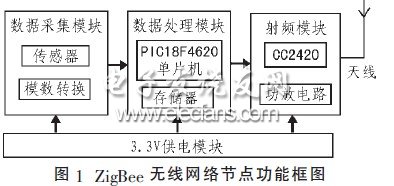1 Introduction The RF transceiver CC2420 uses Chipcon's SmartRF03 technology, adopts 0.18μmCMOS technology, requires few external components, has stable performance and low power consumption, and integrates all the advantages of ZigBee technology, which can be quickly applied to building automation networks and residential security systems , Industrial control network, remote meter reading and PC peripherals and other ZigBee products, can also replace the existing control network technology (such as RS-422, RS-485) and wired monitoring solutions. Because the wireless sensor network consumes a lot of energy in communication, the PIC18F4620 microcontroller with less power consumption is selected as the processor, and the CC2420 is used as the communication device to design the wireless network node. Design. 2 Introduction to CC2420 CC2420 has 33 16-bit configuration registers, 15 command strobe registers, one 128-byte RXRAM, one 128-byte TXRAM, and one 112-byte security information memory. TX and RXRAM can be accessed by address or by using two 8-bit registers. Using the latter to access the memory is the same as accessing the FIFO buffer. It cannot read / write any data to the safety information RAM. As a memory access, RXRAM can only be accessed by FIFOS, and the operation of the register can be used in a slave manner through the SPI interface. The CC2420 has a built-in low-IF receiver, which is responsible for processing the RF signal received by the antenna, amplified by a low-noise amplifier (LNA), and down-converted to a 2MHz IF signal by an I / Q quadrature balance circuit. The signal is then filtered, amplified, A / D converted, automatic gain control, channel filtering, despreading, symbol correlation and byte synchronization to recover the correct data. When sending data, you should first put the data to be sent into a 128-byte send buffer. The header and start frame are automatically generated by the hardware. The internal structure of CC2420 has the following performance characteristics: unlicensed frequency band: operating frequency band range from 2.400 to 2.4835GHz; low data transmission rate: 2M / s direct spreading sequence baseband modulation and demodulation and effective data rate of 250Kbits; low current consumption and high Receiving sensitivity: receiving 19.7mA, transmitting 17.4mA, receiving sensitivity is -94dBm; high reliability: The CSMA / CA technology is adopted to avoid competition and conflicts in sending data. The MAC layer adopts a fully confirmed data transmission mode. Each sent data packet must wait for the receiver's confirmation information; high security: based on CRC (cyclic redundancy calibration) Verification) data packet integrity check function, supporting authentication and authentication, using advanced encryption standard (AES2128) symmetric cipher, to ensure safe data transmission; small size package: QLP-48 package, 7mm & TImes; 7mm; simple interface configuration: and The interface configuration of the microprocessor is simple (4-bus SPI interface). 3 ZigBee wireless network node hardware design According to the ZigBee sensor network node management mechanism, the nodes are divided into three types: sensor nodes, cluster head nodes and sink nodes. When the node is used as a sensor node, it mainly collects the data of the surrounding environment (temperature, displacement, light sensitivity, humidity, etc.) through the sensor, and then performs A / D conversion, which is processed by the processor, and finally sent to the adjacent node by the RF module. At the same time, the node should also perform the data forwarding function, that is, send the data sent by the neighboring node to the sink node or the collection date closer to the sink node; when the node is a cluster head node, it mainly collects all the data in the cluster. The information collected by the node is sent to the aggregation node after data fusion; when the node is the aggregation node, its main function is to connect the sensor network and an external network (such as the Internet), and the data collected by the sensor node through the Internet or satellite Send to users. Although the functions of the nodes are different, the hardware circuits are basically the same. The design uses the PIC18 series of microcontrollers + CC2420 solutions, so to create a ZigBee sensor node, you must have the following components: sensor device, PIC18F4620 microcontroller with SPI interface, CC2420RF transceiver with required external components, antenna (PCB lead antenna or single Polar antenna), 3.3V regulated power supply. The entire hardware system is divided into four modules: data acquisition, data processing, radio frequency, and power supply, as shown in Figure 1. 3.1 Data acquisition module The data acquisition module uses sensors to monitor the external environment, such as temperature, humidity, liquid level, displacement, speed, and other analog parameters, and then sends it to the single-chip microcomputer for processing through A / D conversion. 3.2 Data processing module The processor is the center of the entire node, and other modules must be controlled by the processor, so the performance of the processor determines the performance of the entire node. The processor adopts PIC18F4620 single-chip microcomputer, which has a 10-channel analog-to-digital conversion module with 13 channels, a wide working voltage of 2.0 to 5.5V, and a built-in 3986 byte SRAM for storing data and a 64K byte Flash for storing program code , JTAG program download and online debugging interface, support 4-wire SPI and I2C master-slave mode and other features. 4G Panel Antenna,Mobile Phone External Antenna,Indoor Antenna For Gsm,Signal Booster Antenna Shenzhen Yetnorson Technology Co., Ltd. , http://www.yetnorson.com